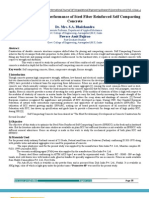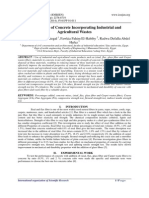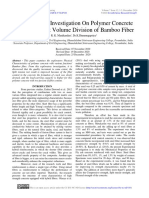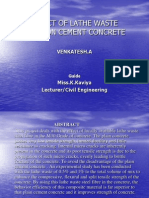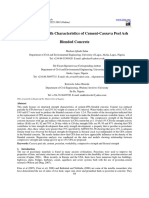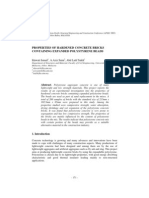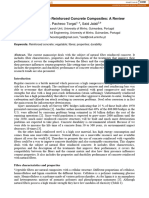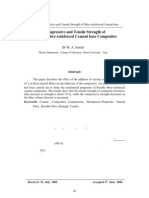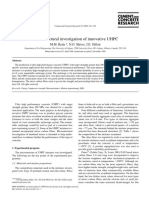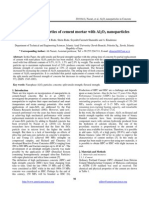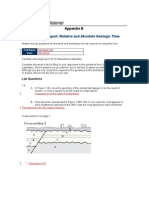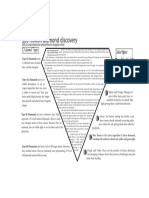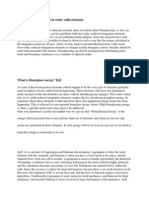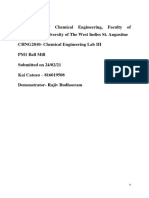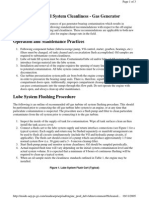tmp4D96 TMP
tmp4D96 TMP
Uploaded by
FrontiersCopyright:
Available Formats
tmp4D96 TMP
tmp4D96 TMP
Uploaded by
FrontiersOriginal Title
Copyright
Available Formats
Share this document
Did you find this document useful?
Is this content inappropriate?
Copyright:
Available Formats
tmp4D96 TMP
tmp4D96 TMP
Uploaded by
FrontiersCopyright:
Available Formats
Advances in Materials
2015; 4(1): 6-10
Published online January 23, 2015 (http://www.sciencepublishinggroup.com/j/am)
doi: 10.11648/j.am.20150401.12
ISSN: 2327-2503 (Print); ISSN: 2327-252X (Online)
Compressive strength characteristics of kenaf fibre
reinforced cement mortar
Omoniyi Tope Moses*, Duna Samson, Othman Musa Waila
Civil Engineering Department, Abubakar Tafawa Balewa University, PMB 0248, Bauchi, Bauchi State, Nigeria
Email address:
tpmomoniyi@gmail.com (O. T. Moses), dunamine@yahoo.com (D. Samson)
To cite this article:
Omoniyi Tope Moses, Duna Samson, Othman Musa Waila. Compressive Strength Characteristics of Kenaf Fibre Reinforced Cement Mortar.
Advances in Materials. Vol. 4, No. 1, 2015, pp. 6-10. doi: 10.11648/j.am.20150401.12
Abstract: This paper presents the findings of an investigation on the compressive strength properties of kenaf fiber composite
mortar. Waterretted kenaf fibers were used as reinforcement in cement mortar. Fiber contents of 1%, 2% and 3 % (by weight of
cement) with varying lengths of 10mm, 20mm and 30mm were used to produce 50mm mortar cubes. The Composite mortars
were cured in water for 3, 7, 14, 21, and 28days. A total of 150 mortar cubes were used for the study. Density, water absorption
and compressive strength tests were conducted on the composite mortar. Regression analysis was carried out on the compressive
strength results using Minitab 15. The results showed that water absorption and density of the composite mortar increased as the
volume of fiber and length increased. Compressive strength decreased with increasing fiber volume and length. However, there
was increase in compressive strength of between 0.21%-22.3% for composite mortar containing 1-3% volume of fiber with
10mm fiber length. The fitted regression model showed a perfect relationship (R2=84.5%) between compressive strength, fiber
volume, fiber length and curing age. Therefore, fiber volume, fiber length and curing are useful predictors of the selected model.
Model adequacy test reveals that the fitted regression model is highly adequate. There was no statistically significant difference
in the compressive strength of the control samples and those containing 1-3% fiber volumes with fiber length of 10mm.
Keywords: Cement, Compressive Strength, Kenaf Fiber, Reinforcement, Mortar, Regression, ANOVA
1. Introduction
In times past, reinforcing steel, plastic and glass fibers
were often used as reinforcement for cement mortar and
concrete. However, these reinforcements are synthetic
materials and expensive [1]. In recent times, a good number
of natural fibers such as, coconut fibers(coir), Sugarcane
bagasse fibers, bamboo fibers, have been used as natural
reinforcement to improve the mechanical properties of
mortar and concrete [2]-[4].
Kenaf fiber has been reported to possess excellent tensile
and flexural strength when compared with other natural
fibers [5]. Hanizam [6] and Ribot [7] reported a tensile
strength of 930MPa and 500MPa respectively. This makes it
an excellent natural fiber in improving the properties of
concrete [8]
Many researchers have carried out investigations into the
properties of concrete using kenaf fiber as reinforcement.
Hanizam [9] investigated the mechanical properties of kenaf
fiber foamed concrete. They included 0.25% and 0.40%
kenaf fiber in foamed concrete and tested the composite
concrete for compressive strength, flexural strength, and
water absorption. Their results showed that kenaf fiber
significantly improved the flexural strength. This increase
reached 61% and 78% for 0.25% and 0.4% kenaf fiber
inclusion respectively. There was also increase in water of
7% and 9% respectively for the same kenaf fiber concrete.
However, there was slight decrease in compressive strength
with inclusion of kenaf fiber. Bhutta [10] used kenaf fiber to
strengthen reinforced concrete beams. Their results reveal
that kenaf fiber increased the ultimate tensile strength of the
composite beams. Arumala [11] grinded kenaf fiber and
mixed it with magnesium oxychloride cement and water to
produce building blocks. Their findings reveal that the blocks
gained compressive strength steadily, attaining about 50% of
the target strength in 15 days. They concluded that the blocks
would be cost effective in the construction of one storey
building. Udoeyo et al [12] used kenaf fiber as reinforcement
in mortar composites of size 650mm x 450mmx 8mm. They
used three fiber contents of 0.5%, 1.0% and 1.5% at four (4)
Advances in Materials 2015; 4(1): 6-10
different fiber lengths of 20mm, 30mm, 40mm and 50mm.
Their results showed that flexural toughness and impact
resistance was enhanced with addition of kenaf fiber.
Although, incorporation of kenaf fiber increased water
absorption of the composite mortar, all the values fell within
the acceptable limit of 16% specified by ASTM C221-77.
This study focuses on the compressive strength of kenaf
fiber reinforced cement mortar. Mathematical models relating
compressive strength, fiber volume and length were proposed
and examined.
2. Materials
2.1. Materials
The kenaf fibers used for this work were obtained from a
farm in Bauchi state, north eastern Nigeria. Water- retting was
carried out on the collected kenaf fiber for four (4) weeks,
after which the fibers were washed and dried. The dried fibers
were chopped into different lengths of 10mm, 20mm and
30mm.Ashaka brand of Ordinary Portland Cement (OPC) was
used throughout the research work. It conforms to BS 12:1978
and the Nigerian Industrial Standard (NIS) 444-1:2003
Specification. The chemical and physical properties of Ashaka
cement are presented in Table 1 and 2 respectively. Fine
aggregate used was river sand obtained from a stream just
outside Bauchi town. The sieve analysis results presented in
Table 3 shows that it falls within zone 2. Portable drinking
water was used for the production of mortar and as such no
test was performed on it.
Table 1. Chemical Properties of Ashaka Cement.
Oxide
SiO2
Fe2O3
Al2O3
CaO
MgO
SO3
Na2O
K2O
Weight (%)
19.68
6.44
3.32
60.92
0.97
2.28
0.12
0.85
limits specified by BS12 (1989)
17-25
3-8
0.5-6.0
60-67
0.1-4.0
1-3
-
2.2. Methods
2.2.1. Mortar Production
A mortar mix of 1: 2.6(cement : sand) was used with a
cement content of 210 kg/m3, fine aggregate, 554 kg/m3 and a
water-cement ratio of approximately 0.55. Batching was done
by means of the weighing balance. The weighed sand and
cement were mixed thoroughly until a homogeneous mixture
was obtained. The required quantity of fiber was added and
mixed carefully to ensure uniformity after which water was
added. 50mm cubes were cast from each mix in accordance
with BS 1881: Part 1 specification. The hardened mortar
samples were demoulded after 24hours and completely
immersed in a curing tank. A total of 150 mortar cubes were
produced for the study.
2.2.2. Water Absorption Test
Water absorption test was conducted on the different
composite mortar after 28days. The test was conducted in
accordance in accordance with BS 1881 Part 122:1982.
2.2.3. Density Test
Density of the composite mortar was determined in
accordance with BS 1881: Part 107:1983 specification. The
test was conducted on the compressive strength specimens
before they were crushed to failure.
2.2.4. Compressive Strength Test
Compressive strength test was conducted on the kenaf fiber
reinforced cement mortar. The test was conducted in
accordance with ASTM C109-1990.Three cubes were cast for
each fiber volume and length. They were crushed at the end of
each curing period using the compressive strength test digital
machine (TQ SM 100) and the average crushing strength
recorded. A total of 150 mortar cubes were produced for the
study.
3. Results and Discussion
3.1. Water Absorption and Density of the Composite Mortar
Table 4. Densities and Water absorption of the composite Mortar.
Table 2. Physical Properties of Ashaka Cement.
Oxide
Specific Gravity
Fineness(m2/kg)
Loss on ignition
Soundness(mm)
Weight (%)
3.15
370
1.0
2
limits specified by BS12 (1989)
275
1.2
10
Table 3. Sieve Analysis of fine aggregate.
Oxide
10mm
5mm
2.36mm
1.18mm
600m
300m
150m
75m
Pan
Percentage passing (%)
100
98.2
83.62
63.77
43.77
20.42
2.50
0.54
0.00
limits specified by BS882 (1973)
100
89-100
60-100
30-100
15-100
5-70
0-15
-
Mix
ID
Fiber
Volume(%)
Fiber
Length(mm)
Density(kg/m3)
KF0
KF1
KF2
KF3
KF4
KF5
KF6
KF7
KF8
KF9
0
1.0
2.0
3.0
1.0
2.0
3.0
1.0
2.0
3.0
0
10
10
10
20
20
20
30
30
30
2400
2408
2424
2512
2520
2556
2560
2392
2344
2328
Water
Absorption
(%)
3.27
3.23
3.19
3.31
3.51
3.41
3.56
3.48
4.20
4.42
The water absorption and densities of the composite mortar
is presented in Table 4. The water absorption values of all the
composite mortar is seen to be slightly more than that of the
control sample except for mortar containing 10mm fiber
Omoniyi Tope Moses et al.:
Compressive Strength Characteristics of Kenaf Fibre Reinforced Cement Mortar
length at 1% and 2% fiber volume. Similar findings had been
reported by Udoeyo et al [13]. The increased water absorption
may be attributed to the increase in void and pore with the
inclusion of kenaf fiber in the cement mortar However, all the
water absorption values fall within the 16% acceptable limit
specified by ASTM C 211-77. This implies that kenaf fiber
length of 10mm and no more than 2% fiber volume can be
used to reduce the water absorption of mortar and
consequently improve its durability.
The densities of the composite mortar were observed to be
slightly greater than that of the plain mortar. This may be
attributed to the increased in weight of the composite mortar
through the inclusion of kenaf fiber.
3.2. Compressive Strength of Composite Mortar
end of 3,7,14,21 and 28 days of curing. This behavior may be
due to the presence of lignin in the kenaf fiber used in the
production of composite mortar. It has been reported that
lignin can improve the compressive strength of cement paste
[14]. Compressive strength was also seen to increase with
curing age irrespective of the volume of fiber or fiber length.
Table 5. Compressive strength of composite Mortar.
Mix
ID
KF0
KF1
KF2
KF3
KF4
KF5
KF6
KF7
KF8
KF9
Vf(%)
Lf(mm)
0
1
2
3
1
2
3
1
2
3
0
10
10
10
20
20
20
30
30
30
Compressive Strength(N/mm2)
3days 7days 14days 21days
9.20
10.6
12.7
13.7
6.82
8.40
10.10
11.6
9.22
11.04
14.18
16.76
5.18
6.54
7.68
13.62
5.27
7.01
7.85
10.09
8.68
10.52
12.78
14.10
4.12
6.02
6.99
7.55
4.26
5.28
6.04
8.04
6.98
7.12
7.38
8.16
2.20
3.20
4.00
5.22
28days
15.20
14.20
18.44
15.50
11.17
15.28
8.67
8.50
9.32
7.24
4. Statistical Analysis
Regression model was fit using the compressive strength
data. The compressive strength ,fc was taken as the dependent
variable while the fiber length, fl, fiber volume(vf) and curing
age Ca were taken as the in dependent variable. The result is
presented in Table 6. The regression equation is given by:
f c = 7.83 + 6.79v f 0.389l f + 0.243ca 2.21v 2f + 0.0523vl l f
Figure 1. Plot of Compressive strength versus Curing age.
Figure 2. Plot of Compressive strength versus fiber volume and fiber length.
The compressive strength test results are presented in Table
4. Figure 1 and 2 shows the variation of compressive strength
with fiber length (fl), fiber volume (vf) and curing age(Ca). It
can be seen that the compressive strength of the composite
mortar containing Vf of 2%, Lf =10mm, and Vf of 2%,
Lf=10mm showed improvement when compared with the
control samples. For instance, for the mix designated Vf2Lf10,
the compressive strength of this mortar increased by 0.21%,
4.2%,11.7%,22.3% and 21.3%of the control samples at the
The coefficient of variation of the fitted model(R-Squared)
gave a value of 84.5%. This value is expected to be as high as
possible to prove the relationship or connections between two
or more variables in a model. Coefficient of variation of
84.5% implies that 84.5% of variation in the compressive
strength is explained by the regression model with fiber length,
fiber volume and curing age as variables. This shows a perfect
correlation and the generated model is highly significant. The
P-values in Table 6 is a measure of the likelihood that the true
coefficient is zero. If the P-value of any independent variable
is less than the selected level of significance (i.e. 5% level of
significance, P0.05), then the variable in question is not
significant. It can be deduced that all the variables are
significant except the interaction variable (VfLf).Figure 3 and
4 shows the model adequacy test plots. The constant variance
assumption was checked with residual versus fits plots shown
in Figure 3. The plot showed a random distribution of the
residuals on both sides of the zero error line. As it can be seen,
the residuals(noise) have non-recognizable pattern. (i.e. the
variance is constant), there were no unusual observations
which further confirms the adequacy of the proposed
model[15]. The population normality was checked with the
normal probability plot as shown in Figure 4. It can be clearly
seen that the residuals aligns themselves closely and tends to
resemble a straight line with not so much variation[16].The
compressive strength test results of the composite mortar were
subjected to a one way ANOVA at 5% level of significance.
The computations are presented in Table 8. There was no
Advances in Materials 2015; 4(1): 6-10
significant difference between means of the compressive
strength of the control mortar and those of the mixes
designated KF1, KF2, KF3 and KF5 (P0.05). Therefore,
mortar containing not more than 1-3% with fiber length of
10mm only can be used where strength is the criterion.
Figure 3. Residual versus fitted value plot for compressive strength.
Figure 4. Normality Probability Plot.
Table 6. Regression analysis on Compressive strength tests results.
Table 8. One way ANOVA for Strength at 5% level of Significance.
Predictors
Coeff
SE Coeff
Significance
Mix ID
Constant
7.83
0.765
10.23
0.00
Yes
KF0
12.28
5.76
Vf
7.79
1.09
6.19
0.00
Yes
KF1
10.22
8.16
0.253
N.S
Lf
-0.38
0.059
-6.53
0.00
Yes
KF2
13.93
14.74
0.440
N.S
Yes
KF3
9.70
20.88
0.297
N.S
KF4
8.28
5.62
0.029*
SS
KF5
12.27
7.15
0.996
N.S
KF6
6.67
2.95
0.0028*
SS
KF7
6.42
3.27
0.0024*
SS
KF8
7.79
0.94
0.0047*
SS
KF9
4.37
3.79
0.0000*
SS
Ca
0.243
0.025
9.90
0.00
Vf2
-2.20
0.365
-6.04
0.00
Yes
VfLf
0.052
0.028
1.82
0.076
No
Table 7. ANOVA for Compressive strength test results.
Source
Regression
Error
Total
DF
5
44
49
SS
597.62
109.53
707.15
MS
119.52
2.49
48.01
0.00
Mean Strength
Variance
*NS means not significant, *SS means significant difference.
Remarks
10
Omoniyi Tope Moses et al.:
Compressive Strength Characteristics of Kenaf Fibre Reinforced Cement Mortar
5. Conclusions
Based on the outcome of this work, the following
conclusion can be made:
1) The addition of kenaf fiber generally increased the water
absorption of the composite mortar.
2) 1% and 2% fiber addition with 10mm length reduced the
water absorption of the composite mortar by up to
2.44%.
3) The densities of the composite mortar increased with
increasing fiber length and volume.
4) Compressive strengths of the composite mortar
increased at 2% fiber volume with 10 and 20mm lengths
and decreased for other mixes at all curing ages.
5) Maximum strength increase was observed at 2% fiber
volume and 10mm fiber length. This value reached 22.3%
of the strength of the control mortar.
6) There is no statistically significant difference in the
compressive strength of mortar containing 1-3% fiber
volume with 10mm length against those used as control
samples.
7) From this study, 1- 3% fiber volume with 10mm length
can be used to improve the compressive strength of
mortar.
8) Fitted regression model on the compressive strength is
highly significant.
9) Due to the high coefficient of variation(R2=84.5%), fiber
volume, fiber length and curing age are significant
predictors of the regression model.
References
[1]
Paul, A.C, John, J.B and Steven, J.F(1999). Agricultural waste
materials for composites: A Canadian reality. Paper Presented
at Center for Management Technology, Global Panel Based
Conference, Nikko Hotel, Kuala Lumpur, 18-19 October, 1999.
[2]
Othman, M.W (2011). The Effects of Kenaf Fiber on the
strength of cement Mortar .Unpublished B.Eng Thesis, Civil
Engineering Department Abubakar Tafawa Balewa University,
Bauchi.
[3]
Kurtis, K.E. (2007)..CEE 8813 Natural Fiber Reinforced
concrete,<http://www.ce.gatech.edu/%/ natfiber.pdf.html >,
accessed November 2014.
[4]
Ghazali, M.J, Azhari, C.H, Abdullah, S and Omar, M,Z(2008).
Characterization of Natural Fibers(Sugarcane Bagasse) in
cement Composites. Proceedings of the world congress on
Engineering, July 2-4, London U.K
[5]
Prakash, T(2009). Processing and Characterization Of Natural
Fiber Reinforced Polymer Composites. Unpublished B.Tech
Thesis, Mechanical Engineering Department, National Institute
of Technology Rourkela India.
[6]
Hanizam,A,Maydin,A.O andAhmad,M.H (2013). Mechanical
and Durability properties of fiber lightweight foamed concrete.
Australian Journal of Basic and Applied Sciences. 7(7), 14-21.
[7]
N.M.H, Ribot, Z, Ahmad, and N.K Mustaffa(2011)
Mechanical Properties of Kenaf Fiber Composite using
Co-cured In-Line Fiber Joint, International Journal of
Engineering Science and Technology. 8,(3), 269-272.
[8]
I.S. Aji, S.M. Sapuan1, E.S. Zainudin and K. Abdan(2009),
Kenaf fibers as reinforcement for polymeric composites: a
review, International Journal of Mechanical and Materials
Engineering,4(3), No. 3, 239-248.
[9]
Hanizam,A,Maydin,A.OandAhmad,M.H (2013). Mechanical
and Durability properties of fiber lightweight foamed concrete.
Australian Journal of Basic and Applied Sciences. 7(7), 14-21.
[10] Bhutta,M.A.
NurHafizah,
A.K,
Jamaludin,
M.Y,
Warid,M.HIsmail,M and Azman, M(2009).Strengthening
reinforced concrete beams using kenaf fiber reinforced
polymer composites laminates.Proceedings of the
international conference on sustainable construction materials
and technologies.
[11] Arumala,J(2014).Kenaf building Blocks. Proceedings 121st
ASEE Annual Conference and Exposition, June 15-18,
Indianapolis.
[12] F.F Udoeyo and A ,Adetifa(2012) Characteristics of Kenaf
Fiber-Reinforced Mortar Composite, International Journal of
Reviews and Engineering Research.12,(1), 18-26.
[13] F.F Udoeyo and A ,Adetifa(2012) Characteristics of Kenaf
Fiber-Reinforced Mortar Composite, International Journal of
Reviews and Engineering Research.12,(1), 18-26.
[14] Akriti, A ,Nirmala K and Soumitra B(2014). Derivatives and
Applications of Lignin An Insight. The SciTech Journal. 1(7),
30-36
[15] Multiple Regression and Model Checking (2011). Tutorial,
Department of Mathematics and Statistic, University of
Reading. pp 1-6.
[16] John Pan (2011). Minitab Tutorial and Design of Experiment.
pp1-32
You might also like
- Kourio Hacks Cheats ScriptDocument51 pagesKourio Hacks Cheats Scriptivanmihnenko09No ratings yet
- ELEN 20044 IM Fundamentals of Electrical Circuits EditedDocument78 pagesELEN 20044 IM Fundamentals of Electrical Circuits EditedChelsiemea VargasNo ratings yet
- High-Strength Flowable Mortar Reinforced by Steel Fiber: M. Ramli, E. Thanon DawoodDocument7 pagesHigh-Strength Flowable Mortar Reinforced by Steel Fiber: M. Ramli, E. Thanon DawoodvietpineNo ratings yet
- International Journal of Engineering Research and DevelopmentDocument4 pagesInternational Journal of Engineering Research and DevelopmentIJERDNo ratings yet
- Coconut Fiber in Concrete To Enhance Its Strength and Making Lightweight ConcreteDocument5 pagesCoconut Fiber in Concrete To Enhance Its Strength and Making Lightweight ConcreteIndrawan Soleh PutraNo ratings yet
- Sheep Wool ConcreteDocument10 pagesSheep Wool Concretesharin vargheseNo ratings yet
- "Study of Natural Fibers As An Admixture For Concrete Mix Design" (Chapter 2)Document9 pages"Study of Natural Fibers As An Admixture For Concrete Mix Design" (Chapter 2)JOHN FHILIP ORIT100% (4)
- Optimum Fly Ash and Fiber Content For M20 Grade ConcreteDocument5 pagesOptimum Fly Ash and Fiber Content For M20 Grade ConcreteIJMER0% (1)
- Experimental Study On Human Hair As Fiber Reinforced ConcreteDocument5 pagesExperimental Study On Human Hair As Fiber Reinforced ConcreteYogendra PatilNo ratings yet
- Performance of Steel Fiber Reinforced Self Compacting ConcreteDocument5 pagesPerformance of Steel Fiber Reinforced Self Compacting ConcreteInternational Journal of computational Engineering research (IJCER)No ratings yet
- An Investigation of Steel Fiber Reinforced Concrete With Fly AshDocument5 pagesAn Investigation of Steel Fiber Reinforced Concrete With Fly AshmaheshNo ratings yet
- (167 176) V10N8CTDocument10 pages(167 176) V10N8CTJERIN K GEORGENo ratings yet
- An Experimental and Characteristic Study of AbacaDocument10 pagesAn Experimental and Characteristic Study of AbacaJilliNo ratings yet
- الفصل الأول (E) PDFDocument27 pagesالفصل الأول (E) PDFhani barakatNo ratings yet
- Performance of Concrete Incorporating Industrial and Agricultural WastesDocument11 pagesPerformance of Concrete Incorporating Industrial and Agricultural WastesIOSRJEN : hard copy, certificates, Call for Papers 2013, publishing of journalNo ratings yet
- Vegetable Fibre Reinforced Concrete Composites: A Review, Said JalaliDocument6 pagesVegetable Fibre Reinforced Concrete Composites: A Review, Said JalaliOmar Imad SrajNo ratings yet
- Project-Based Learning: Developing Ductile Concrete: Shane M. PalmquistDocument9 pagesProject-Based Learning: Developing Ductile Concrete: Shane M. PalmquistArsam HaqNo ratings yet
- Ijaret: ©iaemeDocument5 pagesIjaret: ©iaemeIAEME PublicationNo ratings yet
- Structural Behaviour of Fibrous Concrete Using Polypropylene FibresDocument4 pagesStructural Behaviour of Fibrous Concrete Using Polypropylene FibresPatricia ClarkNo ratings yet
- Mechanism and Strengthening Effects of Carbon Fiber On Mechanical Properties of Cement MortarDocument6 pagesMechanism and Strengthening Effects of Carbon Fiber On Mechanical Properties of Cement MortarIJAERS JOURNALNo ratings yet
- Application of Ultra CelluloseDocument23 pagesApplication of Ultra CelluloseFlavio RojasNo ratings yet
- Toughness Study On Fly Ash Based Fiber Reinforced Concrete: Originalresearch Open AccessDocument4 pagesToughness Study On Fly Ash Based Fiber Reinforced Concrete: Originalresearch Open AccessvitusstructuresNo ratings yet
- Resumo Alargado - Nuno FerreiraDocument14 pagesResumo Alargado - Nuno Ferreiraمهيب الطالبNo ratings yet
- 9.2 Properties of Natural Fiber Cement Boards For Building PartitionsDocument6 pages9.2 Properties of Natural Fiber Cement Boards For Building PartitionsShaz ShaNo ratings yet
- Behaviour of Different Types of Fibre Reinforced Concrete Without AdmixtureDocument7 pagesBehaviour of Different Types of Fibre Reinforced Concrete Without AdmixtureShruti SharmaNo ratings yet
- T01 07 Ivanic - Kravanja - Lubej - GNP2020Document7 pagesT01 07 Ivanic - Kravanja - Lubej - GNP2020Kenan KajosevicNo ratings yet
- CivilDocument2 pagesCivilShiyaNo ratings yet
- Materials: Engineering Properties and Correlation Analysis of Fiber Cementitious MaterialsDocument13 pagesMaterials: Engineering Properties and Correlation Analysis of Fiber Cementitious MaterialsDaniel GiraldoNo ratings yet
- A Study On The Shrinkage Control of Fiber Reinforced Concrete PavementDocument8 pagesA Study On The Shrinkage Control of Fiber Reinforced Concrete PavementShahid Lima KhanNo ratings yet
- Application of Woven Waste Tires Gabion Wall As SLDocument8 pagesApplication of Woven Waste Tires Gabion Wall As SLXzk MallaboNo ratings yet
- IJSET 10 Strength and WorkabilityDocument13 pagesIJSET 10 Strength and WorkabilitytonydisojaNo ratings yet
- Effect of Lathe Waste Review 1Document22 pagesEffect of Lathe Waste Review 1dreamboy87No ratings yet
- Compressive Behavior of Rice Straw-Reinforced Concrete For Rigid PavementsDocument8 pagesCompressive Behavior of Rice Straw-Reinforced Concrete For Rigid PavementsAngelica CabreraNo ratings yet
- Chapter One 1.0 1.1 Background of StudyDocument45 pagesChapter One 1.0 1.1 Background of StudyUzoma FrancisNo ratings yet
- Hadi CP 1-4Document59 pagesHadi CP 1-4Hadi Iz'aanNo ratings yet
- Strength Behavior of Bamboo Reinforced CDocument9 pagesStrength Behavior of Bamboo Reinforced CBRYLLE KYLLE OIDEMNo ratings yet
- Irjet V5i4297Document2 pagesIrjet V5i4297Cornelia BaeraNo ratings yet
- Natural Fibre Reinforced Cement Concrete: Avenue Through Some InvestigationsDocument5 pagesNatural Fibre Reinforced Cement Concrete: Avenue Through Some InvestigationsKirsten CarlosNo ratings yet
- FIBRE REINFORCED CONCRETE USING DOMESTIC WASTE PLASTICS AS FIBRES by R. Kandasamy and R. MurugesanDocument8 pagesFIBRE REINFORCED CONCRETE USING DOMESTIC WASTE PLASTICS AS FIBRES by R. Kandasamy and R. MurugesanIvan KotNo ratings yet
- WPFRC 7Document13 pagesWPFRC 7Tesema LegeseNo ratings yet
- Experimental Study On Human Hair Fiber Reinforced Concrete With Partial Replacement of Cement by GgbfsDocument11 pagesExperimental Study On Human Hair Fiber Reinforced Concrete With Partial Replacement of Cement by GgbfsmohanNo ratings yet
- Structural Strength Characteristics of Cement-Cassava Peel Ash Blended ConcreteDocument11 pagesStructural Strength Characteristics of Cement-Cassava Peel Ash Blended ConcreteMUSTAPHA SHEHU ABUBAKARNo ratings yet
- Properties of Hardened Concrete Bricks Containing Expanded Polystyrene BeadsDocument9 pagesProperties of Hardened Concrete Bricks Containing Expanded Polystyrene BeadsrabikantNo ratings yet
- Jeas 1216 5411 PDFDocument6 pagesJeas 1216 5411 PDFHAJARA SULTHANANo ratings yet
- Vegetable Fibre Reinforced Concrete Composites: A Review, Said JalaliDocument6 pagesVegetable Fibre Reinforced Concrete Composites: A Review, Said JalaliShamsullah NooriNo ratings yet
- Experimental Study On High Strength and Low Shrinkage ConcreteDocument3 pagesExperimental Study On High Strength and Low Shrinkage ConcreteijaertNo ratings yet
- Compressive and Tensile Strength of Natural Fibre-Reinforced Cement Base CompositesDocument10 pagesCompressive and Tensile Strength of Natural Fibre-Reinforced Cement Base CompositesNelson OkoyeNo ratings yet
- The Economics, Performance, and Sustainability of Internally Cured Concrete, Part 3Document9 pagesThe Economics, Performance, and Sustainability of Internally Cured Concrete, Part 3masteriragaNo ratings yet
- Oscar Power PointDocument36 pagesOscar Power PointAbdullahi MuhammadNo ratings yet
- Physical and Mechanical Properties of ConcreteDocument5 pagesPhysical and Mechanical Properties of ConcreteInternational Journal of Research in Engineering and TechnologyNo ratings yet
- A Study On Strength of Concrete by PartiDocument9 pagesA Study On Strength of Concrete by Partijobcustodio54No ratings yet
- M.M. Reda (1999)Document7 pagesM.M. Reda (1999)kashifNo ratings yet
- Mechanical Properties of Cement Mortar With Al O NanoparticlesDocument4 pagesMechanical Properties of Cement Mortar With Al O NanoparticlesSridhar DineshNo ratings yet
- Zeleni BetonDocument6 pagesZeleni BetonNikola JankovicNo ratings yet
- Jurnal Studi Karakteristik Mekanik Beton Dengan Menggunakan Agregat Halus Tailing Dengan Variasi Serat BajaDocument13 pagesJurnal Studi Karakteristik Mekanik Beton Dengan Menggunakan Agregat Halus Tailing Dengan Variasi Serat BajaIrsas InsanilNo ratings yet
- Cect 2024Document11 pagesCect 2024v91201509No ratings yet
- JFRP PR 0.27Document12 pagesJFRP PR 0.27merajulislam.me.kuetNo ratings yet
- Asbestos SheetDocument5 pagesAsbestos SheetPraveenkumar ShanmugamNo ratings yet
- Nahushananda Chakravarthy H.GDocument11 pagesNahushananda Chakravarthy H.GGlobal Research and Development ServicesNo ratings yet
- AFBAD2A10971Document10 pagesAFBAD2A10971Samuel NkereuwemNo ratings yet
- A Comparative Study of Mechanical Properties of Zinc Acrylate Epoxy nanocomposites Reinforced by AL2O3 and Cloisite®30B and Their Mixture: Tensile Strength and Fracture Toughness: A Comparative Study of Mechanical Properties of Zinc Acrylate Epoxy nanocomposites Reinforced by AL2O3 and Cloisite®30B and Their Mixture: Tensile Strength and Fracture ToughnessFrom EverandA Comparative Study of Mechanical Properties of Zinc Acrylate Epoxy nanocomposites Reinforced by AL2O3 and Cloisite®30B and Their Mixture: Tensile Strength and Fracture Toughness: A Comparative Study of Mechanical Properties of Zinc Acrylate Epoxy nanocomposites Reinforced by AL2O3 and Cloisite®30B and Their Mixture: Tensile Strength and Fracture ToughnessNo ratings yet
- Tmp1a96 TMPDocument80 pagesTmp1a96 TMPFrontiersNo ratings yet
- tmpF178 TMPDocument15 pagestmpF178 TMPFrontiersNo ratings yet
- tmpE3C0 TMPDocument17 pagestmpE3C0 TMPFrontiersNo ratings yet
- Tmpa077 TMPDocument15 pagesTmpa077 TMPFrontiersNo ratings yet
- tmp998 TMPDocument9 pagestmp998 TMPFrontiersNo ratings yet
- tmp96F2 TMPDocument4 pagestmp96F2 TMPFrontiersNo ratings yet
- tmp27C1 TMPDocument5 pagestmp27C1 TMPFrontiersNo ratings yet
- tmp3656 TMPDocument14 pagestmp3656 TMPFrontiersNo ratings yet
- tmp97C8 TMPDocument9 pagestmp97C8 TMPFrontiersNo ratings yet
- tmpA7D0 TMPDocument9 pagestmpA7D0 TMPFrontiersNo ratings yet
- Glg101r2 Appendix e Lab ReportDocument4 pagesGlg101r2 Appendix e Lab ReportSusan TuckerNo ratings yet
- DimondDocument1 pageDimondapi-318888783No ratings yet
- Electrical Skills (Eepw2241) : DC MotorsDocument6 pagesElectrical Skills (Eepw2241) : DC MotorsVenkata Rajkumar ChNo ratings yet
- Axial Thrust Load Prediciton of Centrifugal CompressorsDocument44 pagesAxial Thrust Load Prediciton of Centrifugal CompressorsTaylor100% (1)
- V-RAYforC4D 3-4-01 FINAL Readme PDFDocument5 pagesV-RAYforC4D 3-4-01 FINAL Readme PDFOmar AguilarNo ratings yet
- ME2308 Lab ManualDocument28 pagesME2308 Lab ManualNishanth ShannmugamNo ratings yet
- Hourglass IngDocument10 pagesHourglass Ingnickhil851No ratings yet
- Search Techniques Entry ExitDocument7 pagesSearch Techniques Entry ExitJavier Andres Martinez OrtegaNo ratings yet
- Battery Testing GuideDocument32 pagesBattery Testing Guidedabic_zoran100% (2)
- Acoustic Emission Source Detection Using The Time Reversal Principle On Dispersive Waves in BeamsDocument6 pagesAcoustic Emission Source Detection Using The Time Reversal Principle On Dispersive Waves in BeamsEddy PachecoNo ratings yet
- Maintenance Component Main Function Level Activity Frequency Line DepartmentDocument7 pagesMaintenance Component Main Function Level Activity Frequency Line DepartmentBarath100% (1)
- F1-27 Instruction ManualDocument39 pagesF1-27 Instruction ManualMohamed LhocineNo ratings yet
- Schedule B.SC - Sem-V Exam 2023-24Document1 pageSchedule B.SC - Sem-V Exam 2023-24kishanNo ratings yet
- Green Expansion CylindricalDocument52 pagesGreen Expansion CylindricalAG OctavioNo ratings yet
- Composite Beam DesignDocument204 pagesComposite Beam DesignNyein ZawNo ratings yet
- Engineering Design Guideline - Boilers Rev 1.1 WebDocument20 pagesEngineering Design Guideline - Boilers Rev 1.1 Webcaod1712No ratings yet
- SR ChromasitDocument28 pagesSR Chromasitcatalin_adina100% (1)
- MSDS 134aDocument7 pagesMSDS 134aGamaliel Efren Santibañez RomeroNo ratings yet
- Ball MillDocument37 pagesBall MillElisha DanielNo ratings yet
- Synthesis and Characterization of Co2FeAl Heusler Alloy NanoparticleDocument5 pagesSynthesis and Characterization of Co2FeAl Heusler Alloy Nanoparticlekarthik kaonNo ratings yet
- Off Engine Lube Oil System Cleanliness - Gas GeneratorDocument3 pagesOff Engine Lube Oil System Cleanliness - Gas GeneratorDenis JimenezNo ratings yet
- Comprehensive Revision Planner (Lakshya Batch)Document1 pageComprehensive Revision Planner (Lakshya Batch)K VIKASNo ratings yet
- Questions For Quiz BowlDocument8 pagesQuestions For Quiz BowlkNo ratings yet
- Roots of Quadratic FunctionDocument15 pagesRoots of Quadratic FunctionAsi SiaNo ratings yet
- 10 MensurationDocument44 pages10 MensurationSridevi KamapantulaNo ratings yet
- Books Doubtnut Question BankDocument56 pagesBooks Doubtnut Question Bankpinkichoudhary4747No ratings yet
- Slide CIV308 CIV308 Slide 02Document23 pagesSlide CIV308 CIV308 Slide 02Steffy CatharinaNo ratings yet
- Quiz Questions Force and ThermalDocument18 pagesQuiz Questions Force and ThermalwillNo ratings yet









